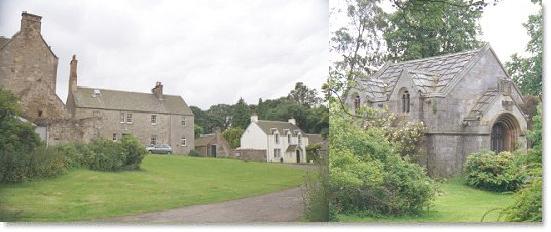The Lands and Estate of
Abercorn
 Abercorn
(Gaelic: Obar Chùirnidh) is a village and parish in West Lothian, Scotland.
Close to the south coast of the Firth of Forth, the village is around 5 km (3
miles) west of South Queensferry. Lying about three miles west of South
Queensferry, Scotland, is the tiny hamlet of Abercorn. Abercorn House is the
largest house left in the Hamlet.
A castle also existed here from Norman times, although it was demolished in 1455
by James II during a siege against the “Black” earls of Douglas. The House of
the Binns, seat of the Dalyell family, is within the parish.
Abercorn
(Gaelic: Obar Chùirnidh) is a village and parish in West Lothian, Scotland.
Close to the south coast of the Firth of Forth, the village is around 5 km (3
miles) west of South Queensferry. Lying about three miles west of South
Queensferry, Scotland, is the tiny hamlet of Abercorn. Abercorn House is the
largest house left in the Hamlet.
A castle also existed here from Norman times, although it was demolished in 1455
by James II during a siege against the “Black” earls of Douglas. The House of
the Binns, seat of the Dalyell family, is within the parish.
The Anglo-Norman knight, Sir William de
Graham, ancestor of the Dukes of Montrose, received from David I. (1124-53) the
lands of Abercorn, which came by marriage to Sir Reginald Mure, chamberlain of
Scotland in 1329. In 1454 the Castle was taken by James II. from the ninth and
last Earl of Donglas, and its only vestige is a low green mound, fronting the
church and manse: whereas Midhope Tower, bearing a coronet and the initials J.
Livingstone, stands almost perfect, ¾ mile SW.
At present there are titularly
connected with this parish Sir Bruce Maxwell Seton of Abercorn, eighth baronet
since 1663; and the Duke of Abercorn, eldest surviving male heir of the Hamilton
line, who takes from it his title of Baron (1603) and Earl (1606) in the peerage
of Scotland, of Marques (1790) in that of Great Britain, and of Duke (1868) in
that of Ireland.
Abercorn, a village and a coast parish of
Linlithgowshire. Lying ¼ mile inland, near the confluence of the Cornie and
Midhope Burns, the village,-a pretty little place, nestling among trees and
gardens on the verge of a high bank,-is 3¾ miles W of its post-town South
Queensferry, and 3 NNW of Winchburgh station. Here stood most probably the
monastery of Aebbercurnig or Eoriercorn, founded about 675 under St Wilfrid as a
central point for the administration of the northern part of his diocese, which
included the province of the Picts, held in subjection by the Angles of
Northumbria.
The Bede mentions Abercorn as the site of a monastery and seat of Bishop
Trumwine. This is now known to have existed close to the present day church. The
church itself dates partially from the 12th century, although its most
interesting features are the private aisles created for the three major families
of the area, the Dalyells, the Hamiltons, and later the Hopes, who had their own
enclosure behind the altar built by architect William Bruce. The Hope mausoleum,
designed by William Burn, is located in the kirkyard. Older burial monuments
include Viking “hogback” stones, and fragments of 7th century crosses.
Trumuini made this monastery the seat of his bishopric, the
earliest in Scotland, from 681 to 685, when the Picts' victory at Dunnichen
forced him to flee to Whitby (Skene, Celt. Scot., i. 262-268, and ii.
224). And here still stands the ancient parish church, refitted in 1579, and
thoroughly repaired in 1838, with a Norman doorway turned into a window, a
broken cross, and a stone coffin lid, but minus a carved pew-back that found its
way to the Edinburgh Antiquarian Museum in 1876.
The parish itself contains also the hamlets of Philipston, 2½
miles SW of Abercorn village, and Society, on the coast, 1¼ mile E by N. It is
bounded N for 3¾ miles by the Firth of Forth (here 2½ miles wide), E by Dalmeny,
SE by Kirkliston, S by the Auldcathie portion of Dalmeny and by Ecclesmachan, SW
by Linlithgow, and W by Carriden, from which it is parted by the Black Burn.
The lands of Abercorn were granted to Claud Hamilton in the
16th century. His son was created earl of Abercorn. In the
17th century the estate was sold by the Seton's to the Hope
family who were created Earls of Hopetoun, and built
Hopetoun House to the east of the village.
Abercorn’s
population was recorded as 1,044 at the time of the 1821
census, although it has since declined.
 Abercorn
(Gaelic: Obar Chùirnidh) is a village and parish in West Lothian, Scotland.
Close to the south coast of the Firth of Forth, the village is around 5 km (3
miles) west of South Queensferry. Lying about three miles west of South
Queensferry, Scotland, is the tiny hamlet of Abercorn. Abercorn House is the
largest house left in the Hamlet.
A castle also existed here from Norman times, although it was demolished in 1455
by James II during a siege against the “Black” earls of Douglas. The House of
the Binns, seat of the Dalyell family, is within the parish.
Abercorn
(Gaelic: Obar Chùirnidh) is a village and parish in West Lothian, Scotland.
Close to the south coast of the Firth of Forth, the village is around 5 km (3
miles) west of South Queensferry. Lying about three miles west of South
Queensferry, Scotland, is the tiny hamlet of Abercorn. Abercorn House is the
largest house left in the Hamlet.
A castle also existed here from Norman times, although it was demolished in 1455
by James II during a siege against the “Black” earls of Douglas. The House of
the Binns, seat of the Dalyell family, is within the parish.